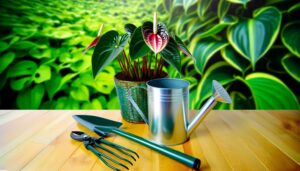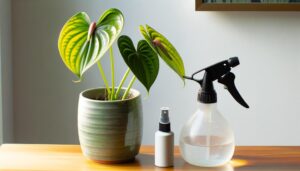How to Care for Anthurium Roots Above Soil: Expert Tips!
To care for anthurium roots above soil, mist them regularly to maintain moisture, as these roots absorb water and nutrients from the air. Confirm your environment is well-ventilated to prevent fungal growth.
Aim for 70-80% humidity, utilizing a humidifier or humidity trays if necessary. Proper soil mix is key: merge 40% orchid bark, 30% peat moss, 20% coconut coir, and 10% perlite.
Water when the top inch of soil is dry, using filtered or rainwater, and guarantee good drainage to avoid root rot. There’s more to securing your anthurium thrives in the sections to come.
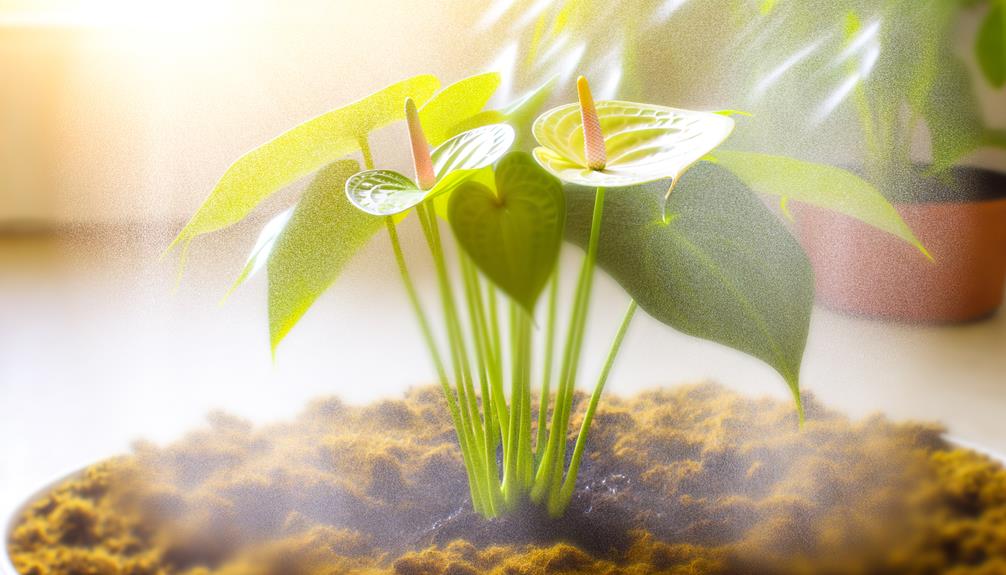
Key Takeaways
- Regularly mist aerial roots to maintain moisture levels.
- Ensure the plant is in a well-ventilated area to prevent fungal growth.
- Use a humidity tray to increase moisture around the aerial roots.
- Employ clean, sharp tools for any necessary pruning.
- Inspect aerial roots weekly for pests and treat promptly.
Understanding Anthurium Roots
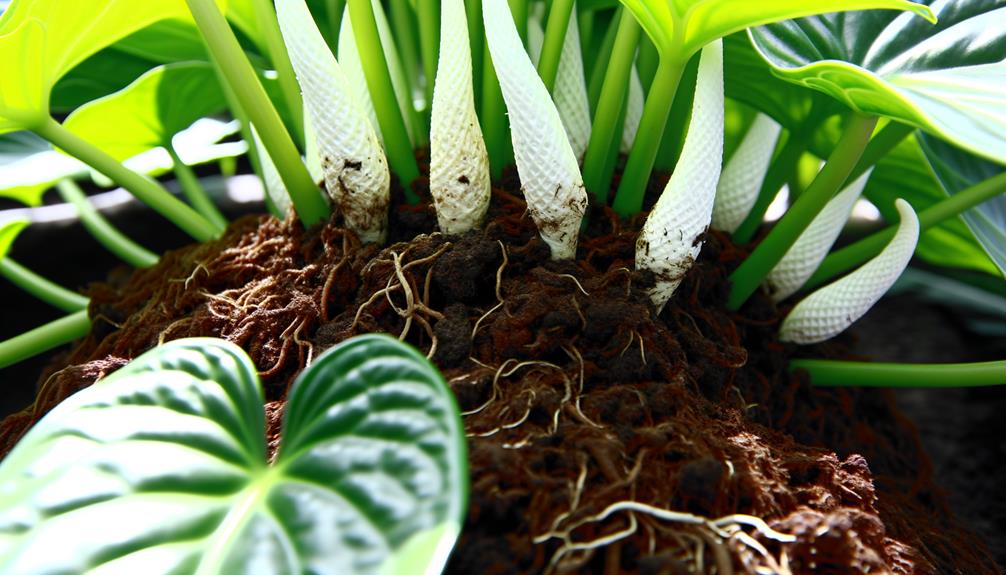
Anthurium roots, which are often aerial and adapted to absorb moisture and nutrients from the air, play a crucial role in the plant’s overall health and growth.
You’ll find that these roots are specially designed to thrive in humid environments. They’ve a spongy texture, allowing them to efficiently uptake water and essential minerals.
When caring for these roots, make sure they’re exposed to adequate humidity but avoid waterlogging them. Mist the roots regularly using a fine spray to maintain moisture levels. Ensure the plant is in a well-ventilated area to prevent fungal growth.
Understanding these unique roots will enable you to provide the best care, guaranteeing your Anthurium remains vibrant and thriving.
Importance of Above-Soil Roots
Recognizing the significance of above-ground roots is crucial for optimizing the health and growth of your Anthurium. These roots play a pivotal role in the plant’s overall well-being. Understanding their importance can help you care for your Anthurium more effectively.
- Air Exchange: Above-ground roots enhance the plant’s ability to exchange gases, allowing for better oxygen intake and improved respiration.
- Nutrient Absorption: These roots can absorb moisture and nutrients from the air, supplementing what the plant gets from the soil.
- Stability: They provide additional support, stabilizing the plant and preventing it from toppling over.
Ideal Soil Mix
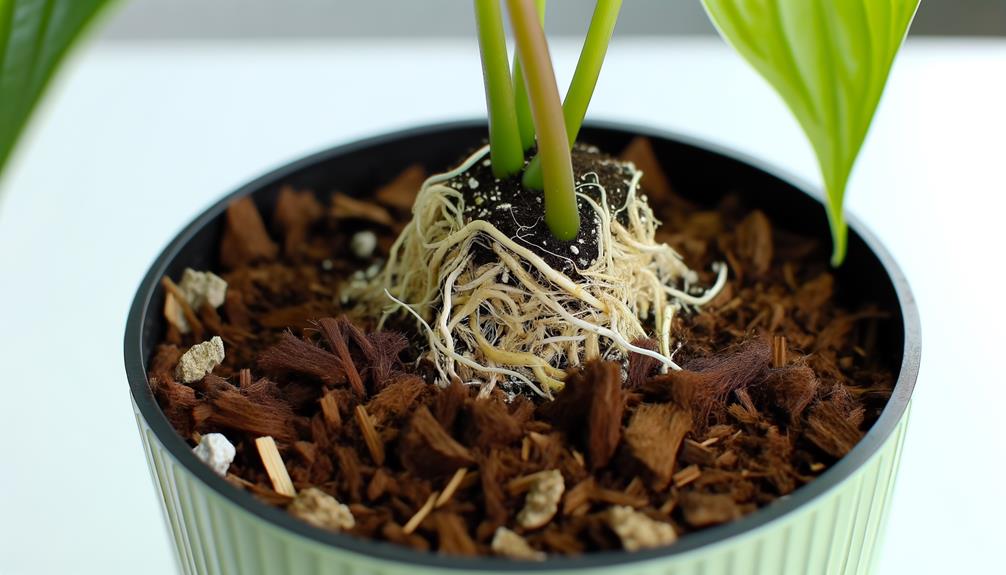
To support the health of both above-ground and below-ground roots, you need an ideal soil mix that provides excellent aeration and drainage. Start with a base of orchid bark, which offers necessary structure and air pockets.
Add peat moss for moisture retention and coconut coir for its outstanding water-holding capacity and resistance to compaction. Finally, include perlite to ensure peak drainage and prevent root rot.
Here’s a simple soil mix recipe:
| Component | Proportion |
|---|---|
| Orchid Bark | 40% |
| Peat Moss | 30% |
| Coconut Coir | 20% |
| Perlite | 10% |
Proper Watering Techniques
To guarantee your anthurium thrives, you’ll need to master watering frequency and moisture level monitoring. Water the plant when the top inch of soil feels dry, but avoid letting it completely dry out.
Use a moisture meter to gauge the soil’s dampness accurately and prevent overwatering.
Watering Frequency Guidelines
Maintaining ideal moisture levels for anthurium roots above soil involves closely monitoring the plant’s hydration needs and adjusting your watering schedule accordingly.
To promote the best health, follow these guidelines:
- Watering Frequency: Water your anthurium when the top inch of soil feels dry. Overwatering can lead to root rot, so it’s essential to let the soil dry out slightly between waterings.
- Water Quality: Use filtered or rainwater to avoid chlorine and fluoride, which can harm the roots. The water should be at room temperature to prevent shocking the plant.
- Drainage: Guarantee your pot has adequate drainage to prevent water from pooling at the bottom. This helps maintain proper root aeration and prevents waterlogging.
Moisture Level Monitoring
Accurately gauging the moisture level in your anthurium’s soil guarantees you provide just the right amount of water, preventing both under-watering and over-watering.
Use a moisture meter for precise readings; insert it into the soil near the roots but avoid direct root contact. Aim for a reading in the middle range, indicating lightly moist soil.
Check moisture levels bi-weekly, adjusting frequency based on seasonal changes. If you prefer manual checks, insert your finger about an inch into the soil. If it feels dry at that depth, it’s time to water.
Always use room-temperature water and make sure proper drainage to avoid root rot. Consistent monitoring assures your anthurium thrives, displaying vibrant leaves and blooms.
Humidity Requirements
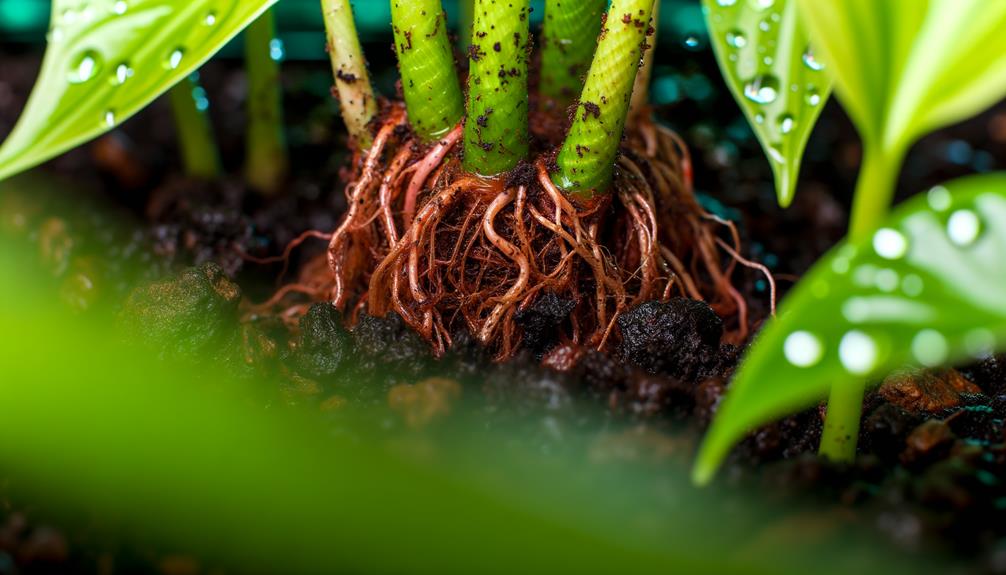
Although Anthurium roots above soil can tolerate varying conditions, they thrive best in high humidity environments to prevent drying out and promote healthy growth. Aim for a humidity level of 70-80%.
Here’s how you can maintain ideal humidity:
- Use a Humidifier: Place a humidifier near your Anthurium to consistently maintain high humidity levels, especially in drier climates.
- Misting: Regularly mist the plant’s aerial roots with water to keep them hydrated. Be cautious not to overdo it, as excess moisture can lead to fungal issues.
- Humidity Trays: Place a tray filled with water and pebbles beneath the plant. As the water evaporates, it increases the surrounding humidity.
Light Conditions
To promote healthy anthurium roots above soil, you need to provide ideal light levels. Place your plant in a spot with bright, indirect light, as direct sunlight can scorch the leaves and roots.
Maintaining the right light conditions will promote vibrant growth and prevent stress on the plant.
Optimal Light Levels
For best growth, make certain your anthurium receives bright, indirect light, as direct sunlight can scorch its leaves. Position your plant in a spot where it can benefit from ample natural light without exposure to harsh rays. The optimal light levels will help your anthurium thrive and maintain its vibrant appearance.
To achieve this, follow these steps:
- Place your plant near an east or north-facing window: These windows provide diffused light ideal for anthuriums.
- Use sheer curtains: Filter intense sunlight by hanging sheer curtains to diffuse direct light.
- Consider artificial lighting: If natural light is insufficient, use fluorescent or LED grow lights to supplement.
Providing the right light conditions will assure your anthurium’s health and strength.
Avoid Direct Sunlight
Why is it important to avoid direct sunlight for your anthurium? Direct sunlight can scorch the leaves and roots, causing irreversible damage.
Anthuriums are native to tropical rainforests where they thrive under canopy cover, hence indirect light mimics their natural habitat best.
Here’s a quick reference table to illustrate the light conditions:
| Light Condition | Effect on Anthurium | Recommendation |
|---|---|---|
| Direct Sunlight | Scorching, leaf burn | Avoid placing in direct sun |
| Indirect Bright Light | Best growth | Preferred placement |
| Low Light | Slowed growth, fewer blooms | Position with filtered light |
Fertilization Tips
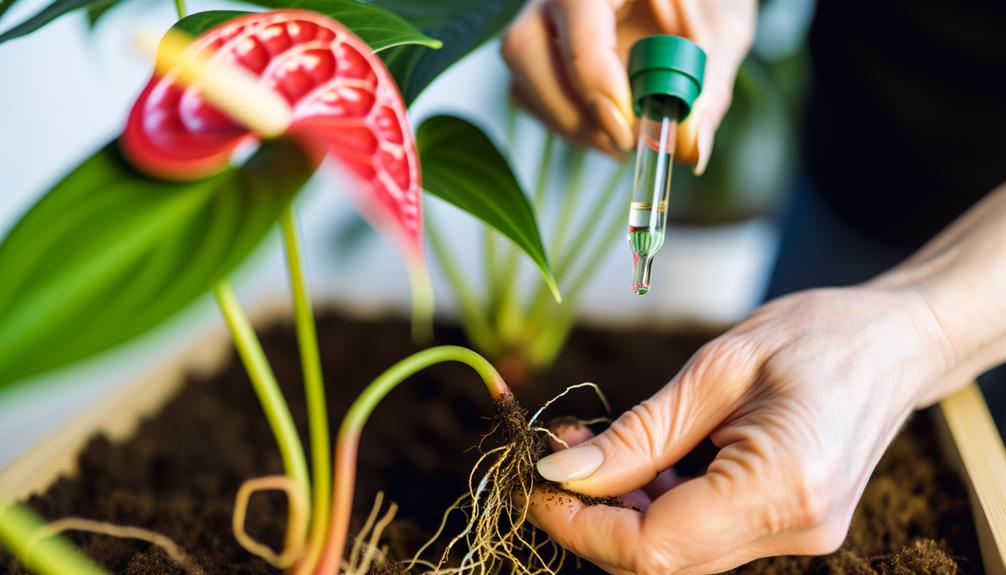
Ensuring your anthurium receives balanced nutrients is crucial for promoting healthy root growth and vibrant blooms. Choose a high-quality, water-soluble fertilizer with a balanced N-P-K ratio, such as 20-20-20.
Follow these steps to guarantee proper fertilization:
- Frequency: Fertilize every 6-8 weeks during the growing season (spring and summer). Reduce the frequency to every 10-12 weeks during fall and winter.
- Dilution: Mix the fertilizer at half the recommended strength to prevent over-fertilizing, which can harm the roots.
- Application: Apply the diluted fertilizer directly to the soil, avoiding contact with the leaves and aerial roots.
Pruning and Maintenance
Regular trimming and maintenance are vital for keeping your anthurium in good health and promoting strong growth. Begin by sterilizing your pruning shears to prevent the spread of disease.
Trim off any yellow or brown leaves, as these can deplete the plant’s energy. Concentrate on eliminating dead or injured roots above the soil to enhance better air circulation and nutrient absorption.
Prune the plant’s stems to shape it and stimulate new growth, cutting just above a leaf node. Always use clean, sharp tools for accurate cuts, reducing strain on the plant.
After trimming, observe the plant for any indications of strain or disease. Consistent attention guarantees that your anthurium stays vibrant and showcases your dedication beautifully.
Dealing With Pests

Anthuriums, like many houseplants, can occasionally fall prey to pests such as aphids, mealybugs, and spider mites, which can damage the plant if not promptly addressed. To effectively manage these pests, follow these steps:
- Inspect Regularly: Check your anthurium’s leaves and roots weekly for signs of pests. Look for small insects, sticky residue, or webbing.
- Use Natural Solutions: Apply neem oil or insecticidal soap to affected areas. These are safe for the plant and effective against a variety of pests.
- Isolate Infected Plants: If you spot an infestation, immediately separate the plant to prevent pests from spreading to others.
Taking these steps guarantees your anthurium remains healthy and vibrant, showcasing your dedication to excellent plant care.
Common Problems and Solutions
Frequently, you’ll encounter a variety of issues with your anthurium, but understanding their causes and implementing targeted solutions can help you maintain a thriving plant.
Root rot is common and typically results from overwatering or poor drainage. Verify your pot has proper drainage holes and use well-aerated soil.
If you notice yellowing leaves, it may indicate nutrient deficiencies. Apply a balanced, water-soluble fertilizer monthly.
Brown leaf tips often signal low humidity; increasing humidity with a pebble tray or humidifier can resolve this.
For root-bound plants, repotting in a slightly larger container will promote healthy root growth.
Consistently monitoring these factors will guarantee your anthurium continues to flourish and serve as a vibrant addition to any space.
Seasonal Care Tips
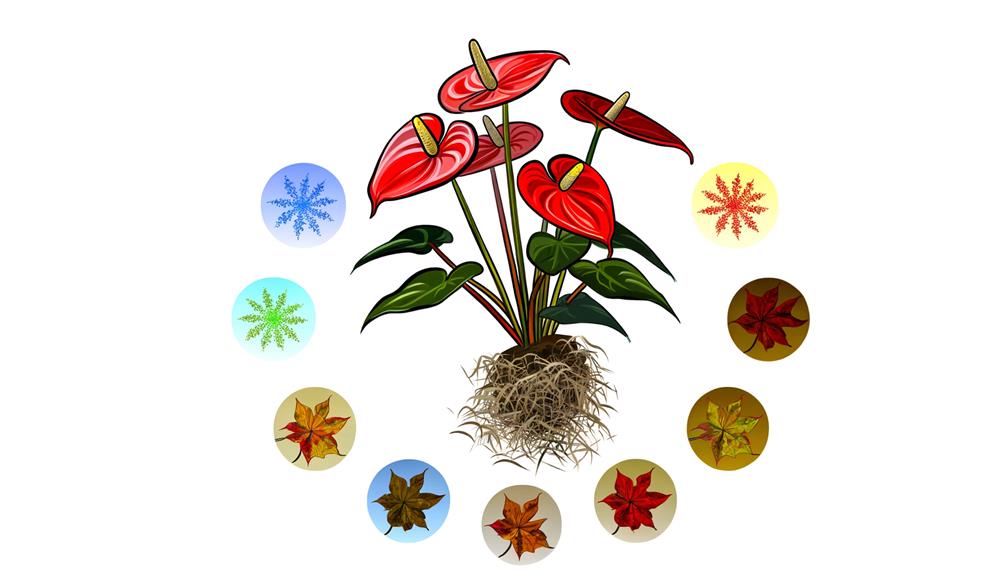
To protect anthurium roots during winter, make certain they’re kept in a warm environment and avoid excessive watering.
In summer, increase watering frequency to keep the roots hydrated but guarantee good drainage to prevent root rot.
Adjusting these routines according to the season will help maintain healthy, thriving roots.
Protecting Roots in Winter
When winter approaches, it’s important to take proactive steps to insulate and protect the exposed roots of your anthurium from the harsh cold. Begin by bringing your plant indoors or to a warmer location if you can.
If relocation isn’t feasible, consider these measures:
- Mulching: Apply a thick layer of organic mulch around the base of the plant. This helps regulate soil temperature and moisture.
- Insulation: Use frost cloths or burlap wraps around the pot or root area to shield against extreme temperature drops.
- Humidity Control: Increase indoor humidity using a humidifier or by placing a water tray near the plant. This prevents the roots from drying out.
Summer Watering Routine
As temperatures rise and winter’s chill fades, adjusting your anthurium’s watering routine becomes essential to guarantee the health and vigor of its exposed roots.
Increase watering frequency, ensuring the soil remains consistently moist but not waterlogged. Use a well-draining potting mix to prevent root rot.
Water early in the morning to allow the soil to dry slightly by evening, reducing the risk of fungal infections. Check the moisture level by inserting your finger one inch into the soil; water if it feels dry.
Mist the aerial roots daily to maintain humidity, mimicking their natural tropical habitat. Placing a humidity tray or using a humidifier can also help.
Always use room-temperature, filtered water to avoid shocking the roots.
Conclusion
In caring for your anthurium roots above soil, remember: their health is your plant’s heartbeat. By mastering ideal soil compositions, precise watering, and maintaining peak humidity levels, you guarantee vibrant growth.
Regular pruning prevents disease, and vigilance against pests keeps your anthurium thriving. Address common issues promptly and adjust care seasonally for optimal outcomes.
Your dedication transforms these elegant plants into living art, echoing nature’s resilience and beauty. Always, let your green thumb guide their flourishing journey.

